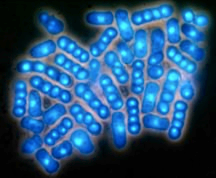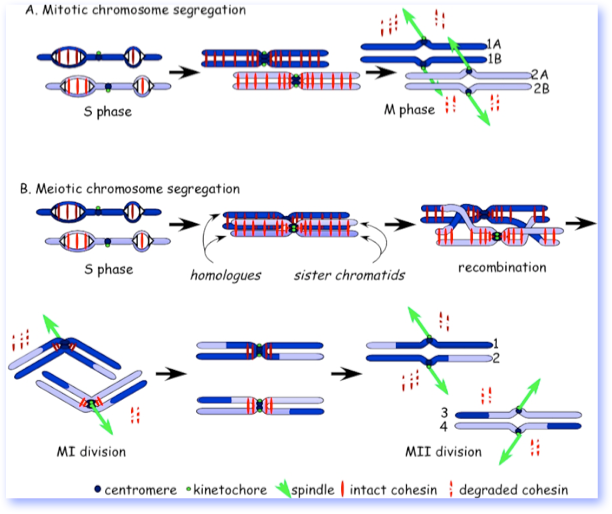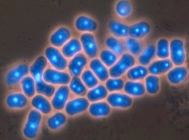 This is a specialized process of cell division that produces gametes (eggs and sperm). It is a differentiation pathway, distinct from the mitotic cycle of normally dividing cells. In humans, it is estimated that at least 10% of conceptions have defects that probably occurred during meiosis of either paternal or maternal gametes. Most of these will result in miscarriage. Understanding the process of meiosis is therefore fundamental to understanding human health and development. This page uses simple schematics to compare mitosis to meiosis in a generalized cell.
This is a specialized process of cell division that produces gametes (eggs and sperm). It is a differentiation pathway, distinct from the mitotic cycle of normally dividing cells. In humans, it is estimated that at least 10% of conceptions have defects that probably occurred during meiosis of either paternal or maternal gametes. Most of these will result in miscarriage. Understanding the process of meiosis is therefore fundamental to understanding human health and development. This page uses simple schematics to compare mitosis to meiosis in a generalized cell.
First, consider mitosis (typical cell division) in a normal diploid cell, with two chromosomes. The chromosomes are duplicated during DNA replication, and the duplicates, called sister chromatids, remain attached to one another via sister chromatid cohesion, until chromosome segregation when the spindle pulls the pairs apart. Each daughter cell then receives one of the sisters from each homologue pair. Importantly, this means that the daughter cells are exact copies of the mother cell, with two copies of each chromosome, so they can go through the same process again. Thus, we call this process the cell cycle. This is the usual process of division by which the cells of our bodies renew themselves.
 Comparison of chromosome dynamics in meiosis and mitosis. From Forsburg, Mol Cell 9:703 (2002)(A) Mitosis in a cell with two chromosomes ensures that each daughter cell receives a copy of each chromosome. Importantly, while the apparatus of mitosis ensures that each daughter cell will have a copy of chromosome 1 and chromosome 2, it does not distinguish which one. That is, the daughters may end up with (1A and 2A), and (1B and 2B). Or, they may end up with (1A and 2B) and (1B and 2A). Since the sister chromatids are identical, this random orientation doesn’t matter. The important thing is that the daughter cells have the exact same chromosome complement as the starting cell: one copy of chromosome 1 and one copy of chromosome 2. (B) In meiosis, the starting diploid is reduced to four haploids. The homologuous chromosomes are duplicated, and paired to one another. Following recombination (see text), the homologues separate in the MI division. The MII division separates the sister chromatids, similar to mitosis. Each daughter nucleus will receive a single chromatid from a single homologue; importantly, because of recombination, the four daughter nuclei will not be genetically identical.
Comparison of chromosome dynamics in meiosis and mitosis. From Forsburg, Mol Cell 9:703 (2002)(A) Mitosis in a cell with two chromosomes ensures that each daughter cell receives a copy of each chromosome. Importantly, while the apparatus of mitosis ensures that each daughter cell will have a copy of chromosome 1 and chromosome 2, it does not distinguish which one. That is, the daughters may end up with (1A and 2A), and (1B and 2B). Or, they may end up with (1A and 2B) and (1B and 2A). Since the sister chromatids are identical, this random orientation doesn’t matter. The important thing is that the daughter cells have the exact same chromosome complement as the starting cell: one copy of chromosome 1 and one copy of chromosome 2. (B) In meiosis, the starting diploid is reduced to four haploids. The homologuous chromosomes are duplicated, and paired to one another. Following recombination (see text), the homologues separate in the MI division. The MII division separates the sister chromatids, similar to mitosis. Each daughter nucleus will receive a single chromatid from a single homologue; importantly, because of recombination, the four daughter nuclei will not be genetically identical.
Things change in mieosis. The purpose of meiosis is to reduce the normal diploid cells (2 copies of each chromosome / cell) to haploid cells, called gametes (1 copy of each chromosome per cell). In humans, these special haploid cells resulting from meiosis are eggs (female) or sperm (male). In yeast cells, they are spores.
To carry out this specialized process, the cells duplicate their DNA but follow this by two rounds of division, instead of one. The first division separates the duplicated homologues from each other. This essentially reduces the number of chromosomes in each cell. Thus, we call this the reductional, or Meiosis I division. The second division operates similarly to the mitotic division, and separates the sister chromatids from one another; we call this the equational, or Meiosis II division. The offspring from meiosis have half the number of chromosomes as their parent cell, because they receive just one copy of each chromosome, rather than two. (Compare the offspring in the meiosis diagram to those in mitosis).
An important additional feature of meiosis is the process of recombination, or genetic exchange between the homologous chromosomes. This is indicated by the swapping of red and blue on the homologous chromosomes in the diagram. Although homologous chromosomes contain the same genes, they may have different versions, or alleles, of each gene. Recombination allows the different versions to be shuffled into new combinations. And, the physcial mechanism of recombination is often required for the chromosomes to segregate properly in the Meiosis I division. Thus, the offspring nuclei differ from the starting diploid in two important ways: first, they have reduced the total amount of genetic information to just one copy per cell, and second, recombination within and between chromosomes means that each meiotic nucleus contains different genetic information.
Finally, to make a diploid again, the haploid gametes produced by each parent will fuse to form a zygote (during fertilization). Thus, the offspring receives one copy of each chromosome from each parent. Depending upon the recombination events that occurred to produce each gamete, genetic information may also be shuffled. This explains why siblings get different combinations of genes from their parents, which is why they look related, but not identical.
All these processes–replication, recombination, and chromosome segregation–are linked, and require successful completion of each preceding stage. Any defects in the careful choreography of meiosis can therefore have profound effects on the health of the gametes and the resulting zygotes. Importantly, up to 50% of human conceptions are thought to result in miscarriage, of which the major fraction is probably due to chromosome abnormalities during meiosis.
Meiosis in Fission Yeast

Fission yeast is a good model for meiosis. The regulation of entry into meiosis is well understood genetically. It occurs in response to nutrient limitation, and the presence of cells of opposite mating types. Cells undergo conjugation, forming a diploid zygote which immediately enters the sporulation pathway. Meiosis will result in each diploid producing a neat package (the tetrad ascus) containing four haploid spores. One of the strengths of yeast is that the ascus allows us to investigate the four products of a single meiosis, which is a very powerful technique. The details of the process, including how work with crosses genetically is described in the pombe technology section of this site.
Although the signal transduction pathways that regulate conjugation and initiation of meiosis in fission yeast are different than humans, many of the processes of meiosis itself, including recombination and chromosome segregation, are regulated by conserved proteins found in humans as well. Thus, fission yeast provides an excellent simple model for studies of this specialized cell differentiation process.
You can read more about our work on meiosis in the research section.